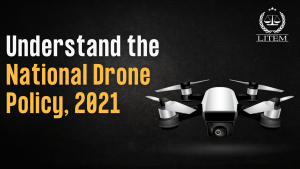Drones, or Unmanned Aircraft Systems (UAS), serve practically every area of the economy, including agriculture, infrastructure, surveillance, emergency response, transportation, geospatial mapping, defense, and law enforcement, to name a few. Because of their reach, variety, and ease of use, drones have the potential to generate enormous employment and economic growth, particularly in India’s remote and inaccessible areas.

The Center has announced on Thursday the new drone policy. The new policy has come up with more relaxation for the general public related to the operation of drones in India. Earlier, there were even limited areas along with a lot of permissions required for the drone operation which now have been given some relaxations. Stick with us for 2 more minutes and you will get all those major updates in this blog.
10 major highlights of the National Drone Policy
- No Permission to operate drones in Green Zones. “Green zones” are the airspace up to a vertical distance of 400 feet that have not been designated as red zone or yellow zone in the airspace map.
- The number of Forms Reduced from 25 to 5. The Ministry of Civil Aviation has eased the rules regarding drone operations in the country by reducing the number of forms that need to be filled to operate them from 25 to 5.
- Types of fees for operation decreased from 72 to 4. The Ministry of Civil Aviation has eased the rules regarding drone operations in the country by decreasing the types of fees charged from the operator from 72 to 4.
- Many Approvals have been Abolished. It Includes unique authorization number, unique prototype identification number, certificate of manufacturing and airworthiness, certificate of conformance, certificate of maintenance, import clearance, acceptance of existing drones, operator permits, authorization of R&D organisation, student remote pilot licence, remote pilot instructor authorisation, drone port authorisation etc.
- The all-up weight of an unmanned aircraft system has been increased from 300 kg to 500 kg. The Ministry of Civil Aviation has notified Drone Rules, 2021, under which the coverage of all-up weight of an unmanned aircraft system has been increased from 300 kg to 500 kg to include heavy payload-carrying drones for use in the logistics and transportation sectors. It will also cover drone taxis.
- There won’t be any restrictions on foreign ownership in Indian drone companies.
- The maximum penalty for violations now is INR 1 lakh.
- QCI (Quality Council of India) or authorized testing entities will now test for the issuance of Type Certificate for drones.
- Type Certificate required only when a drone is to be operated in India. Importing and manufacturing drones purely for exports are exempt from type certification and unique identification numbers. Nano and model drones (made for research or recreation purposes) are exempt from type certification.
- Drone promotion council to be set up by the Government with participation from academia, startups, and other stakeholders to facilitate a growth-oriented regulatory regime.
“Air taxis are being researched globally… and many startups are coming up. The time is not far when like taxis that you see on roads, like Uber, etc., you will see taxis in the air under the new drone policy. I believe this is very possible,” Civil Aviation Minister Jyotiraditya Scindia said.
The New Drone Policy seems to pave the way for drones to carry people as well as goods for transportation. If this would be the case, then we can expect lesser pollution and traffic on the roads also.

